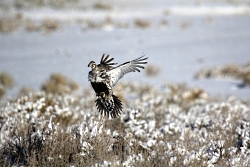
Courtesy & © Nicole Frey, Photographer
With the use of GPS units, scientists and manager are able to witness the positive impacts these treatments are having on Utah’s Greater sage-grouse population. They monitor the movement patterns of the grouse and determine how the birds use their seasonal habitats throughout the year.

Gourtesy & © Nicole Frey, Photographer
Wildlife managers call the grouse a “landscape species” because they have to manage a variety of different communities for the grouse to thrive.
During the months of January and February when the habitat is at its coldest, females and males have the same needs – to stay warm, find food, and avoid predators.
Fortunately, sagebrush provide the resources to meet all these needs.
While grouse huddle under the brush for protection from frigid winds, deepening snow and roaming predators, they avoid having to search for food since the bulk of their nourishment comes from the leaves of the sagebrush. The grouse simply reach up, nibble on the leaves, and remain safe in their protective sagebrush tent.
When they have consumed all the leaves from one bush, they simply move to another sagebrush.

Courtesy & © Nicole Frey, Photographer
By fall, the chicks are grown and the adult females return to the dry sagebrush habitat and prepare for winter.
The biggest struggle sage grouse have in the southern region is a fragmented habitat. They have to fly dangerous distances to reach the variety of habitats they need.

Gourtesy & © Nicole Frey, Photographer
One of the first conservation treatments occurred in Sink Valley in 2005.
Prior to this, female Greater sage grouse in Sink Valley would spend the summers in the agricultural fields south of Alton, which were laced with danger. A couple of times grouse got bailed up and researchers would find the transmitters in a hay bale. At other times, an eagle would carry off birds and the transmitter would be found with a hole in the side from the eagle’s claw.
Within two years after the Sink Valley treatment, researchers stopped finding females anywhere close the agricultural fields. The sage grouse were now able to find grasses and forbs in close proximity to their nests.
Rhett Boswell, Habitat Biologist at Utah Division of Wildlife Resources, who created management tools using Frey’s GPS data explains, “With this GPS [data] we have learned so much, it keeps opening up new opportunities to refine our management prescriptions. With this best available science, we can identify which management treatments have the greatest positive impact and create resource selection models to plan future management.”
In other words, the future of Utah’s Greater Sage Grouse is looking bright.
This is Shauna Leavitt and I’m Wild About Utah.
Decreasing the Habitat Risks of Utah’s Southern Sage-Grouse-Credits:
Photos: Courtesy & Copyright © Nicole Frey Department of Wildland Resources, Quinney College of Natural Resources, Utah State University
Audio: Courtesy and Copyright Kevin Colver
Text: Shauna Leavitt, Utah Cooperative Fish and Wildlife Research Unit, Quinney College of Natural Resources, Utah State University
Decreasing the Habitat Risks of Utah’s Southern Sage-Grouse-Additional Reading
To learn more about Utah sage-grouse conservation, please go to www.utahcbcp.org.
Leavitt, Shauna, Greater Sage-Grouse in Utah, Wild About Utah, June 12, 2017, https://wildaboututah.org/greater-sage-grouse-in-utah/
Leavitt, Shauna, South Canyon Sage-Grouse, Wild About Utah, January 22, 2018, https://wildaboututah.org/south-canyon-sage-grouse/







